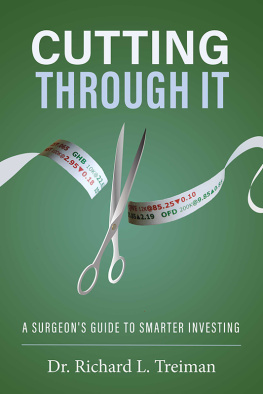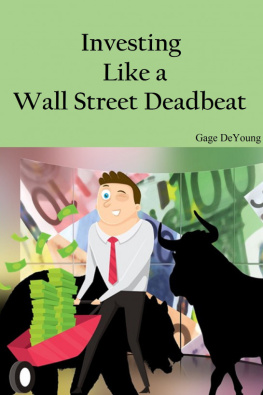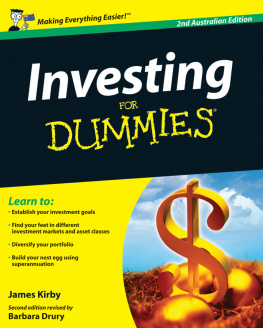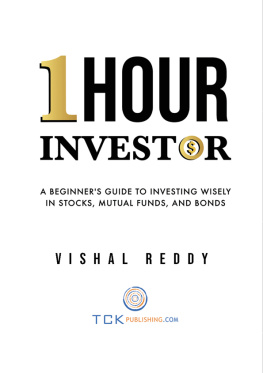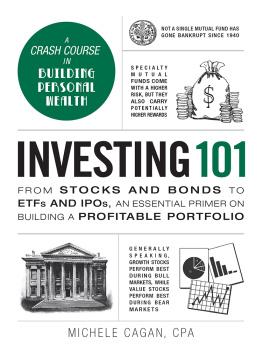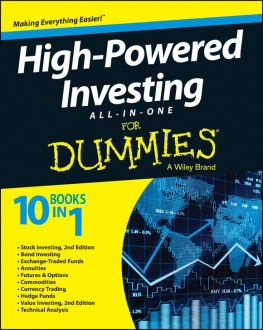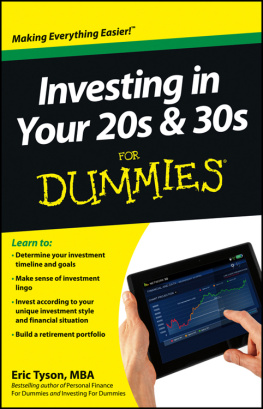CUTTING THROUGH IT
Copyright 2020 by Richard L. Treiman
All rights reserved.
No part of this book may be reproduced in any form or by any electronic or mechanical means, including information storage and retrieval systems, without written permission from the author, except for the use of brief quotations in a book review.
ISBN 978-1-09831-337-1 eBook 978-1-09831-338-8
This book is dedicated to my wife, Bette, who has been my best friend for 60 years.
CONTENTS
FOREWORD
Throughout my 68 years in wealth management, it was my responsibility to help clients manage their investment portfolios and achieve their financial goals. Ive been lucky enough to work with fascinating people, many of whom are leaders in their respective industries and professions. But in spite of how brilliant they may be, I was always surprised by how little some knew about investing and finance. How could it be that basic investing principles havent become a part of common knowledge?
Ive always had a personal interest in enhancing clients understanding of investing and finance. Over the course of my career, Ive combed through the instructional books written by some of the most successful investors of our time. But in spite of impressive author credits, I cant say that the knowledge within these books stuck with readers.
You can imagine my reluctance when I was asked to review a manuscript on investing written by a surgeon with no formal training in finance. The author was Dr. Richard Treiman, a highly-respected vascular surgeon in our community. Dr. Treiman was never a client; he personally managed his accounts and retirement funds from the day that he started his medical practice. As we started discussing his book, I quickly learned that he was no scrub. Not only had Dr. Treiman studied investors such as Benjamin Graham, Burton Malkiel, Howard Marks, Gerald Loeb, and Jeremy Siegel, he brought a unique perspective to the subject. Dr. Treiman wasnt like the other authors who had made careers out of managing exclusive funds. As a successful amateur investor, he had the ability to connect to people like my clients: regular men and women who didnt work on Wall Street.
To my surprise and enjoyment, I was taken by Dr. Treimans manuscript. In the vast ocean of investing information, Dr. Treiman manages to pluck out the select material that a young investor needs to know. The book explains technical formulas and investing principles with crystal-clarity, often using engaging anecdotes and analogies to help the reader retain information. Im impressed by the books easy-to-read writing style, which held my interest. Its the very first book on investing that I can describe as a fun read.
If theres a single word to describe this book, its practical. Whether youre a student wanting to learn about investing, a young adult starting your career, or an established citizen who wants to seize control of your portfolio, this is the book for you. I only wish that Dr. Treiman could have written it 68 years earlier; it would have been my go-to referral for clients.
-Aaron Eshman
Former Senior Vice-President | Morgan Stanley Wealth Management
Past Governor | American Stock Exchange
Past Vice-Chairman | Pacific Stock Exchange
Past Member, Board of Directors | Security Industry Association
INTRODUCTION
About a year ago, my twelve-year-old grandson Jacob approached me after a family dinner.
Grandpa, I have some money and want to buy a stock what should I buy? When I asked Jacob how he had acquired sufficient money to invest, he assured me that hed saved every penny from birthdays and other holidays. I was impressed by that; his decision to forgo buying toys and games to save money for the future is the mentality of a real investor.
I could tell you what Im buying these days, I told him. But Im not sure itll do you much good in the big picture.
Why not?
Well, one stock might look good todaybut how will you know if it meets your expectations? And what about stocks that arent good buys today but become profitable later?
Jacob thought for a moment. Can I ask for your help in the future?
Ill tell you what. Let me teach you the basics of investing, and then you wont need me at all. In time, maybe Ill be the one asking you for advice.
Jacob agreed, and I went to my office where I made notes on the fundamentals of common stocks and investing. Over the following weeks, I guided Jacob through the material, giving him review quizzes and hypothetical situations to navigate. It wasnt long before I was scouring Amazon to find a book on investing that would take Jacobs education to the next level. I was surprised to find that among the sea of books on the subject, very few approach the material from an amateurs perspective. Most titles are written by financial experts who manage hedge funds. But these qualifications dont make them particularly good at leveling with a novice to the investing world.
I ended up purchasing what seemed to be the most accessible book that I could find, but Jacob scarcely made it through the . The book enforced an all-too popular fallacy: investing is dense, boring, and reserved for people in fancy suits.
This fallacy is nothing new. It affected me when I was barely making ends meet as a young doctor. Though Id served in the Navy, made it through medical school, and gotten married, I barely knew the difference between a common stock portfolio and a mutual fund. As I was toiling away at my medical practice, I remember hearing friends and colleagues talking about the stock market and their investments. These conversations intimidated me, quite frankly. Why? I wasnt afraid of tackling a complex surgery or changing my kids diapers. But for some reason, investing was a grizzly bear that I didnt want to confront.
Over the course of my life, Ive found that Im not the only one who felt this way. The average Joes and Janes dont miss out on investing because its difficultthey miss out on investing because its daunting. We seem to share a universal fear of investing that feeds on our ignorance of the subject. It really isnt our fault; courses on financial health arent a part of high school curriculums. That lends itself to quite a bit of confusion over the various types of securities, the risks of investing, the strategy used to evaluate stocks, and the process of using investments to fund retirement.
If it wasnt for hearing about investing from my colleagues in the hospital, I probably would have never gotten involved in investing. But I suppose that peer pressure can be a good thing; I educated myself and built an investment portfolio that ultimately bankrolled my retirement. I say this not for the sake of indulgence, but to make a point: its never too late to get started, and you dont need to be a wolf of Wall Street to succeed as an investor. Though its easy to throw up your hands and pretend that youve missed the investing boat, that simply isnt true. Whether youre nineteen or ninety-one, you can benefit from the stock market if you commit to gaining foundational knowledge.
The goal of this book is to provide you with the tools that are necessary for building a profitable investment portfolio. Using the notes that I prepared for Jacob as an outline, Ive covered not only the essentials of investing, but specific strategies that will lead to financial success over the longterm. Everything that you need to know to become a successful investor is covered in nine accessible chapters. After each chapter, Ive included The Bullet Points that summarize the lessons in bite-sized sentences. Heres what well cover.

